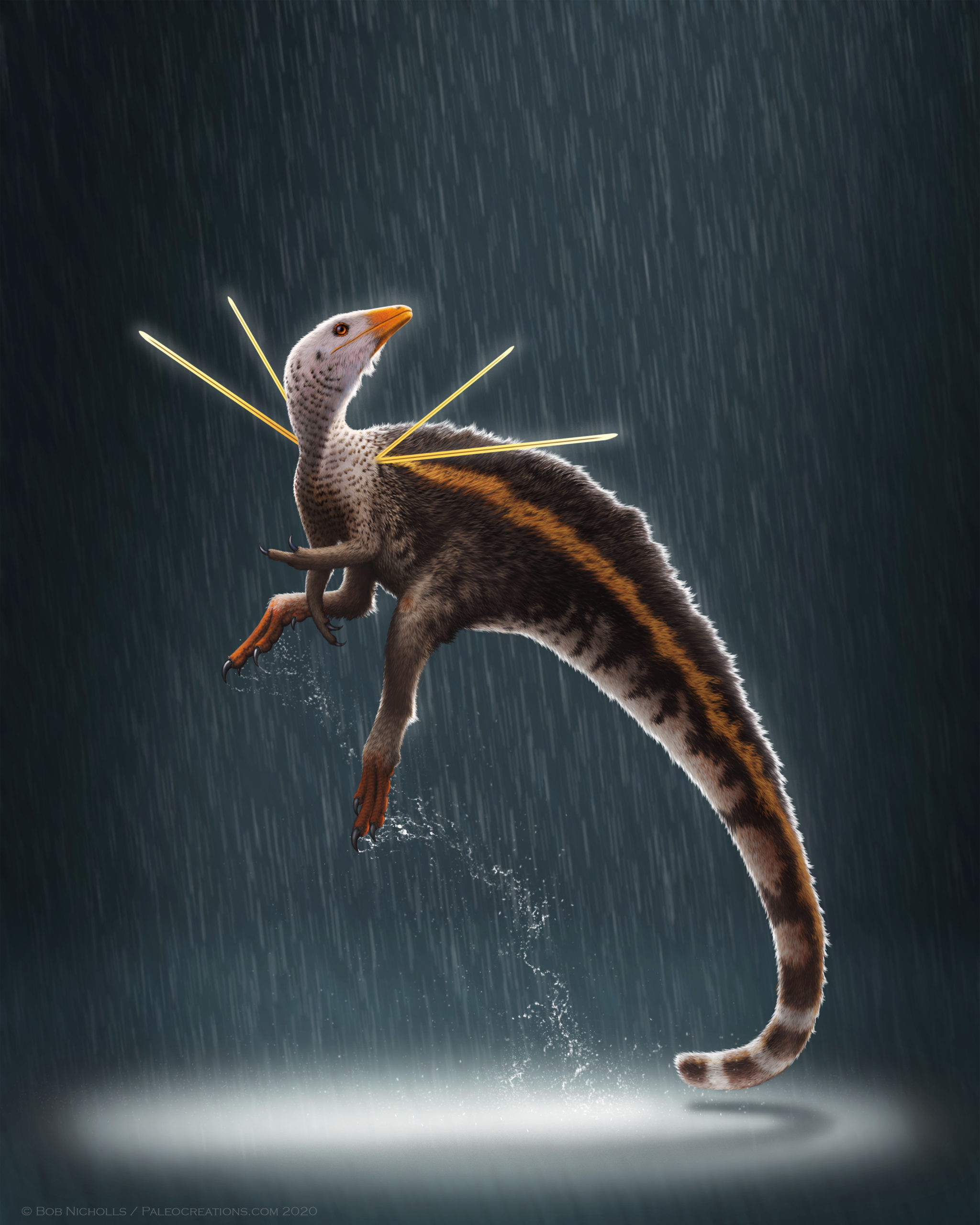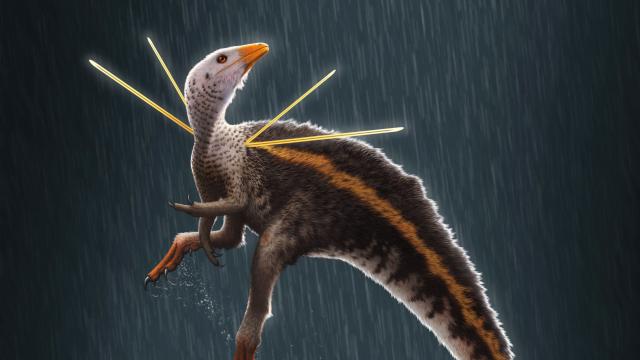The re-analysis of an old fossil has revealed features never seen before in a dinosaur, including a long, fur-like mane along its back and a pair of stiff structures jutting out from its shoulders. Scientists say these elaborate decorations were likely used for display, in what is a very early version of peacocking.
Introducing Ubirajara jubatus, a theropod dinosaur that lived 110 million years ago in the supercontinent Gondwana. In addition to brandishing an impressive mane along its back, Ubirajara featured two pairs of straw-like structures that likely protruded from its shoulders. This feature has never been seen before in a non-avian dinosaur, and it’s reminiscent of the long display feathers seen in the extant male standardwing bird-of-paradise.
That Ubirajara used these elaborate structures for display is a distinct possibility, according to the authors of the new study, published today in the journal Cretaceous Research. The chicken-sized Ubirajara may have flashed the adornment to attract a mate, intimidate male rivals, or scare off potential predators.

The sex of the specimen could not be determined, but this flamboyant display would suggest a male, given differences seen in modern male and female birds. Modern birds and ancient theropods share a common ancestor, and this discovery suggests the whole peacocking thing is something the two groups inherited from earlier dinosaur relatives. Or they acquired the same strategy independently — tough to know.
The partial skeleton was found decades ago in the Crato Formation of northeastern Brazil, and it was preserved across two slabs of limestone that, when combined, “align with each other perfectly,” wrote the authors. The specimen eventually made its way to Germany, where it’s being stored at the State Museum of Natural History in Karlsruhe. Recently, a team of paleontologists decided to take another look at the fossil with a high-resolution digital X-ray machine, revealing the previously unseen features.
Despite the incompleteness of the fossil, the researchers were able to spot well-preserved filamentous structures within the limestone. The long, flat, and stiff filaments were found to be composed of keratin — the same stuff that makes up hair, feathers, and fingernails. These four filamentous structures would normally be tucked into Ubirajara’s body so as to not impede its agility, and they would likely only be deployed when needed, according to the study.
“The ribbon-like structures are unlike anything we’ve seen before. They’re elongate and flat with a ridge running along their length that likely strengthened the structures,” said University of Portsmouth paleontologist Robert Smyth, the paper’s first author, in an email. “Similar-shaped filaments are known in other dinosaurs, but none that are so large in comparison to the size of the animal.”
Smyth said Ubirajara is the earliest branch on the theropod evolutionary tree known to possess such features.
“Until now, elaborate display feathers were thought to be restricted to those dinosaurs that had already evolved complex, bird-like feathers,” he added.
The paleontologists also documented the long, thick mane of fur-like filaments. As the authors speculate, Ubirajara controlled its mane with muscles running along its back, similar to a dog’s raised hackles.
“The ‘mane’ is made up of densely packed elongate monofilaments, similar in thickness to coarse hair, that increase in length from the back of the neck along the back,” wrote Smyth in his email. “We believe that these monofilaments originated from follicles that would have given the dinosaur some ability to raise and lower them.”
Smyth said Ubirajara lived in a semi-arid environment that bordered an ancient sea, and it likely fed on small reptiles and amphibians.
[referenced id=”1147829″ url=”https://gizmodo.com.au/2019/02/newly-discovered-spiked-dinosaurs-from-south-america-look-like-creatures-from-no-mans-sky/” thumb=”https://gizmodo.com.au/wp-content/uploads/2019/02/06/fujqstazlejmyclnalrb.png” title=”Newly Discovered Spiked Dinosaurs From South America Look Like Creatures From ‘No Man’s Sky’” excerpt=”Paleontologists in Argentina have uncovered a dinosaur unlike anything ever seen before. Alive some 140 million years ago, these majestic herbivores featured long, forward-pointing spikes running along their necks and backs. These spikes may have served a defensive role, but their exact purpose now presents a fascinating new mystery.”]
Ubirajara is also important in that it’s the first non-avian dinosaur to be discovered in Brazil’s Crato formation. As for the name, “Ubirajara” means “lord of the spear” in the indigenous Tupi language, and “jubatus” means “maned” or “crested” in Latin.
Finds like this, in which paleontologists are able to study an animal’s exterior structures, are radically changing our conceptions of dinosaurs and what they looked like. At the same time, this sort of research can also yield new insights into their possible behaviours. As for Ubirajara, I’m imaging this little fellow strutting around with his four filamentous structures held high while doing a seductive dance for the dinosaur ladies.
